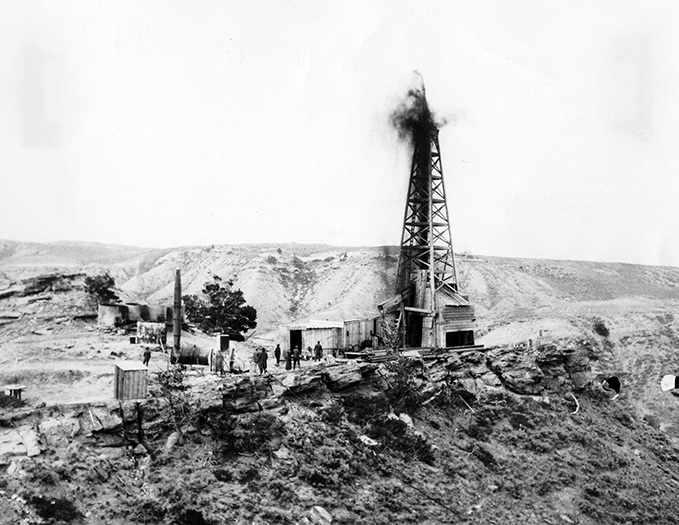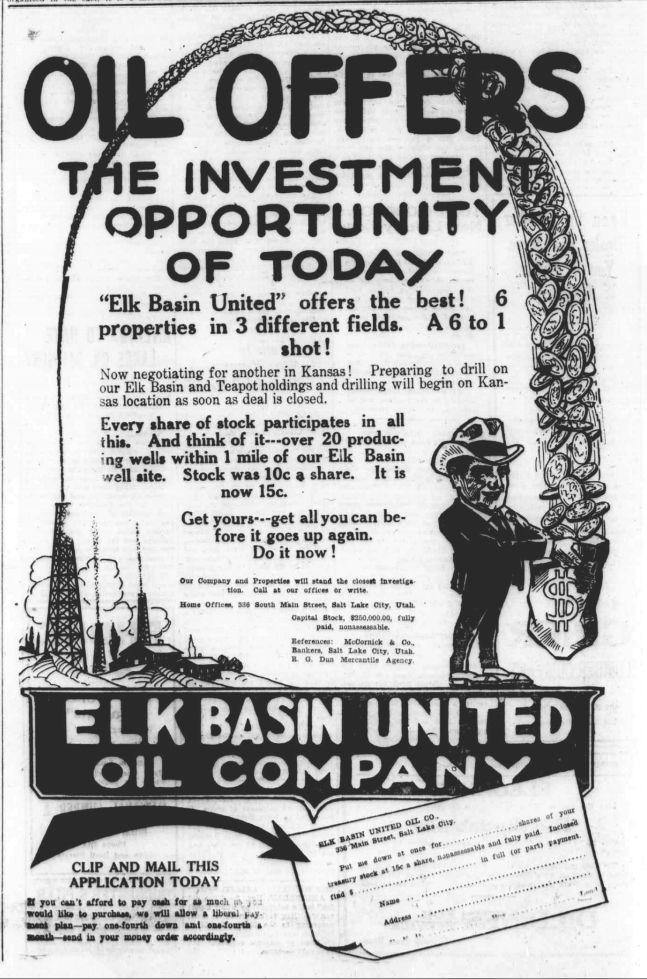Elk Basin United Oil Company
Elk Basin United Oil Company incorporated in 1917 seeking oil riches in Wyoming’s booming Elk Basin oilfield. Oilfields found in North Texas, including a 1911 gusher at Electra, already had resulted in a rush of new exploration ventures – and created boom towns like Burkburnett.
Wherever found, America’s newly discovered oilfields led to the founding of many exploration ventures that competed against more established companies.
Newly formed companies frequently struggled to survive as competition for financing, leases, and drilling equipment intensified, especially as exploration moved westward.
Wyoming Oilfields
In a remote, scenic valley on the border of Wyoming and Montana, a discovery well opened Wyoming’s Elk Basin oilfield on October 8, 1915. Wyoming’s earliest oil wells had produced quality, easily refined oil as early as 1890.
Drilled by the Midwest Refining Company, the wildcat well produced up to 150 barrels of oil a day of a high-grade, “light oil.” Credit for oil discovery is given to geologist George Ketchum, who first recognized the Elk Basin as a likely source of oil.

“Gusher coming in, south rim of the Elk Basin Field, 1917.” Photo courtesy American Heritage Center.Ketchum, a farmer from Cowly, Wyoming, in 1906 had explored the area with C.A. Fisher, who had been the first geologist to map a region within the Bighorn Basin southeast of Cody, Wyoming, where oil seeps were discovered in 1883.
The Elk Basin, which extends from Carbon County, Montana, into northeastern Park County, Wyoming, attracted further exploration after the 1915 well. More successful wells followed.
Once again, petroleum discoveries in unproved territory attracted speculators, investors, and new companies – including the Elk Basin United Oil Company.
Established petroleum companies like Midwest Refining — and the Ohio Oil Company, which would become Marathon Oil — came to the Elk Basin. These oil companies had the financial resources to survive a run of dry holes or other exploration hazards.
The exploration industry’s many smaller and under-capitalized companies would prove especially vulnerable.

Audacious advertising claims helped Elk Basin United Oil Company compete for investors.
Is My Old Oil Stock Worth Anything features several such small players in Wyoming’s petroleum history, including the notorious Dr. Frederick Albert Cook (Arctic Explorer turns Oil Promoter). Even Wyoming’s famous showman, Col. William F. Cody, got caught up in the state’s oil fever (Buffalo Bill Shoshone Oil Company).
Elk Basin United Oil Company
Elk Basin United Oil Company of Salt Lake City, Utah, incorporated on July 30, 1917, and acquired a lease of 120 acres in Wyoming’s Elk Basin oilfield. By February 1918, company stock sold for 12 cents a share.
Enthusiastic newspaper ads promoted its “6 properties in 3 different fields…A 6 to 1 shot!” Twenty producing wells were reputed to be within one mile of Elk Basin United Oil’s Wyoming well site.
Meanwhile, Elk Basin United Oil reported expansion plans underway in a growing Kansas Mid-Continent oilfield. The company secured leases near Garnett and completed four producing oil wells, yielding a total of about 500 barrels of oil a month. It added an additional 112 acres and planned a fifth well.
Prairie Pipe Line Company (later Sinclair Consolidated) completed pipelines into the Garnett field through which several companies looked to transport their oil production.
However, growing competition from better funded exploration ventures and low crude oil prices ranging between $1.10 and $1.98 per barrel of oil in 1917 and 1918 drove many small companies into consolidations, mergers or bankruptcy.
Elk Basin United Oil, exploring back in Wyoming by March 1919, sought a lease on the property of the First Ward Pasture Company bordering the Utah line, “with a view of prospecting the property declare the surface showing to be very favorable for an oil deposit.” But financial issues continued to burden the company.
In December 1919, Oil Distribution News reported Basin United Oil Company was negotiating mergers with the Anderson Oil Company and the Kansas-United Oil Company, with a proposed capitalization of $1 million. With no results of the planned combination documented, Elk Basin United Oil Company disappeared from financial records soon thereafter.
_______________________
The stories of exploration and production companies joining petroleum booms (and avoiding busts) can be found updated in Is my Old Oil Stock worth Anything? Become an AOGHS annual supporting member and help maintain this energy education website and expand historical research. For more information, contact bawells@aoghs.org. Copyright © 2022 Bruce A. Wells. All rights reserved.
Citation Information – Article Title: “Elk Basin United Oil Company.” Authors: B.A. Wells and K.L. Wells. Website Name: American Oil & Gas Historical Society. URL: https://aoghs.org/old-oil-stocks/elk-basin-united-oil-company. Last Updated: September 29, 2022. Original Published Date: October 1, 2021.


